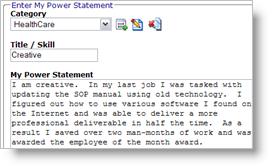
This was such a powerful concept that I decided to include it as a feature in JibberJobber. You’ll find it in the Interview Prep area, where you can enter your personal responses to interview questions (power statements is one of three things you can enter).
What are power statements?
A power statement is made up of three parts, which I explain below. Power statements concisely communicate a specific skill you have with quantifiable evidence. When you have prepared and rehearsed your power statements you convey your skills with authority. Each of the three parts contributes to this authority. Here’s an example:
I am creative. For example, in my last job I was tasked with updating the SOP manual using old technology. I figured out how to use various software I found on the Internet and was able to deliver a more professional deliverable in half the time. As a result I saved over two man-months of work and was received the employee of the month award.
The first part is I am _________. This is where you put a skill, such as ambitious or tenatious. You can also say I am a hard worker. You are simply stating what you are.
The second part is For example, ________________________________________. This is where you tell the story that backs up your skill. It would start off like this: For example, when I was at American Express I …
The third part is As a result _______________________________. This tells why your example is so powerful. You want to quantify the results here, so something like a dollar change, percentage saved, time saved, etc.
Obviously this will come in handy during an interview (it can also provide information to help construct a resume). When you are asked “tell me about a time when you showed X skill” you can deliver a power statement.
As an interviewer I’d really appreciate an answer like this as opposed to a rambling story about all kinds of details that are not important (and detracts from what you have to offer). Ending it with a result ties it all together and nails the point home.
One quick note – in the image you will see the first drop down is “Category” – this is a premium feature which is very cool. After you categorize your interview responses you will be able to print out responses for certain interviews.
For example, I will have specific interview responses for a high-tech startup which will be different than a large university. Or, different responses for a Project Manager position than a Customer Service Manager position.
Create different responses for these different scenerios and then print off just the answers you need before your interviews.
Power statements are included in the free level of JibberJobber. We want you to be able to use this feature extensively. Really, if I were in a job search right now I’d create dozens of power statements that really help communicate my skills and experience. Create these responses and practice them and you should find your networking and job interviews go smoother than you could imagine.
Do me a favor – in the comments leave one of your power statements! If you don’t have one then now’s a good time to create one. Here’s the question: What is one of your greatest strengths?

Just for you, Jason… this is the one I come up with off the top of my head:
I am multi-disciplinary. For example, I’m currently working in internet security, just finished my first book on careers, am a certified hypnotherapist and started my first business at the age of 19. As a result, I can pull in strengths and resources from an incredible number of areas, and apply the patterns of thinking from those disciplines to the problem at hand. This talent has allowed me to pick up new skills incredibly quickly, and I often see problems in different ways than those around me.